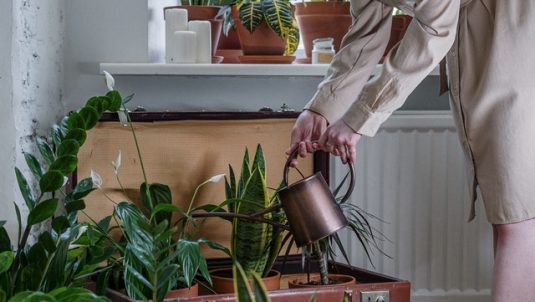Can you garden indoors? It is a question that many people may want the answer to since organic foods are becoming much more in demand than ever before. People are more focused on their health and well-being than they have been in the past, which makes not only organic eating popular but also seeking out great organic food places to enjoy.
When it comes to growing vegetables indoors, there are many benefits that can be cited, such as it saves you time and money at the grocery store. For organic food places, growing vegetables indoors allows workers to spend time perfecting their delicious dishes instead of having to spend time ordering fruits and vegetables from suppliers.
A Few Tips for Gardening Indoors
First of all, you will need to locate a container that is big enough for the roots of your plant to grow and flourish as well as a container that has a drainage hole in the bottom of it. You can make your own container by using some things you may already have one hand at home, such as old storage bins or large plastic ice cream containers. You will want to set your container on some type of pan, dish, or tray so when water drains out it does not ruin the table, cabinet, or window sill that it is sitting upon.
You will want to use high-quality indoor potting soil that is fortified with nutrients that will help your plants grow and fill your container with it. You can plant your vegetable or fruit plants into the soil or you can use seeds and plant those.
When it comes to growing vegetables or fruit indoors, the biggest challenge is usually proper lighting. You can use a window light or even some grow lights that will help your plants flourish since vegetables need at least five or six hours of sunlight per day and fruits can require up to 10 hours per day.
When it comes to watering your plants, keep in mind that less is actually more since they are not being subjected to the intense heat that is produced by direct sunlight. You will want to make sure that you keep the soil moist but not too damp or too dry. Remember to mist your plants with water every day or even use a cold-mist humidifier to increase the humidity so your plants will thrive.
While planting fresh seeds or plants is normally the way people garden, indoors or outdoors, there is another way. When it comes to some types of vegetables and fruits, you can actually use scraps from them to create new plants. Some examples would be celery, lettuce, and green onions. You simply add your scraps to your container with plenty of water on the bottom for them to soak in and be sure they have plenty of natural light. Before you know it, you will have a garden growing in your house, restaurant, or other indoor areas.
When it comes to growing vegetables indoors, there are several of them that have proven to be very successful, especially for people who are new to the indoor gardening process. Read on for more information on each of these vegetables.
Green Onions/Scallions
If you grow green onions in your outdoor garden or your indoor garden, they are super easy to take care of and do not need as much sunlight as some other vegetables. You can start them from seeds or you can use the root of one that you may already have on hand to simply replant and watch it flourish.
Carrots
The great thing about growing carrots in your indoor garden is they don’t need a whole lot of room to spread out. You should use more soil though to plant your carrots since they require to be planted deeper into the soil. Also, keep in mind that they do best at about 60 degrees Fahrenheit since they are very tolerant of cooler environments, and make sure they get plenty of light because they need about 12 hours each day to grow really well.
Hot Peppers
Whether you fancy hot peppers, banana peppers, or jalapeno peppers, you can grow them in your indoor garden. By nature, they are tropical perennials, which means they thrive in very warm weather and full sunlight. They are self-pollinating, which makes them a really great option to grow indoors. They need a high level of light, up to about 20 hours each day, and thrive in temperatures around 70 degrees Fahrenheit. This means you will probably want to use grow lights for sure if you are growing hot pepper varieties. Simply place them in a container that is at least eight inches tall and remember not to water them too often because you want the soil to dry out between each watering session.
Herbs
Herbs are a great option to grow indoors even though they love the sunlight and you’ll want to make sure they get plenty of it by having a grow light on them for up to 16 hours each day. Many people start out with their indoor garden experience by growing herbs and some people even have plant walls that contain tons of potted herbs and spices that they are growing in their kitchen or dining room. Many organic food places that you may eat grow their own herbs and may even use their herb walls as highlights in their restaurants. The best types of herbs for growing indoors include parsley, oregano, sage, thyme, cilantro, mint, chives, and rosemary. These types of plants do you best if your home or restaurant is about 70 degrees Fahrenheit.
Now that you have a few ideas and tips on how to start an indoor garden, you can enjoy organic eating at home by using the vegetables you are growing in your amazing recipes or you can head to one of the many organic food places that serve up the vegetables and fruits that they also grow themselves. Check out the Organic Restaurants website for more information.
Find restaurants with organic options near you
Search by city or see restaurants close to you.



 Sign in with Google
Sign in with Google Sign in with Facebook
Sign in with Facebook